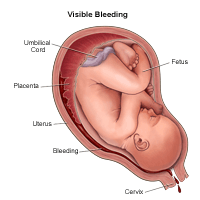Complications of Pregnancy
What are some of the more common complications of pregnancy?
Although the majority of pregnancies are uneventful, sometimes complications do happen. The following are some of the more common pregnancy complications.
Amniotic fluid complications
Too much or too little amniotic fluid in the sac around the fetus may be a sign of a problem with the pregnancy. Too much fluid can put too much pressure on the mother's uterus, leading to preterm labor. It also can cause pressure on the mother's diaphragm. This can lead to breathing difficulties. Fluids tend to build up in cases of uncontrolled diabetes, a multiple pregnancy, incompatible blood types, or birth defects. Too little fluid may be a sign of birth defects, growth retardation, or stillbirth.
Bleeding
Bleeding in late pregnancy may be a sign of placental complications, a vaginal or cervical infection, or preterm labor. Women who bleed in late pregnancy may be at greater risk of losing the fetus and bleeding excessively. Bleeding at any time during the pregnancy should be reported to your healthcare provider right away.
Ectopic pregnancy
An ectopic pregnancy is the development of the fetus outside of the uterus. This can happen in the fallopian tubes, cervical canal, or the pelvic or belly. The cause of an ectopic pregnancy is usually scar tissue in the fallopian tube from infection or disease. The risk of ectopic pregnancy is increased in women who have had tubal sterilization procedures, especially women who were younger than age 30 at the time of sterilization.
Ectopic pregnancies happen in about 1 out of 50 pregnancies and can be very dangerous to the mother. Symptoms may include spotting and cramping. The longer an ectopic pregnancy goes on, the greater the chance that a fallopian tube will rupture. An ultrasound and blood tests may confirm the diagnosis. Treatment of an ectopic pregnancy may include medicine or surgical removal of the fetus.
Miscarriage or fetal loss
A miscarriage is pregnancy loss that happens up to 20 weeks of gestation. Most miscarriages happen before 12 weeks. Miscarriages happen in about 15% of all pregnancies and are usually due to genetic or chromosomal abnormalities.
Miscarriages are usually preceded by spotting and intense cramping. To confirm a miscarriage, an ultrasound and blood tests may be done. The fetus and contents of the uterus are often naturally expelled. If this does not happen, a procedure called a dilation and curettage (D & C) may be necessary. This procedure uses special instruments to remove the abnormal pregnancy.
Fetal loss in the second trimester may happen if the cervix is weak and opens too early. This is called incompetent cervix. In some cases of incompetent cervix, a healthcare provider can help prevent pregnancy loss by stitching the cervix closed until delivery.
Placental complications
Under normal circumstances, the placenta attaches to the uterine wall. However, two types of placental complications may happen, including:
Placental abruption. Sometimes the placenta becomes detached from the uterine wall too soon. This is called placental abruption and leads to bleeding and less oxygen and nutrients to the fetus. The detachment may be complete or partial. The cause of placental abruption is often unknown. Placental abruption happens in about 1 in every 100 live births.
Placental abruption is more common in women who smoke, have high blood pressure, and/or have a multiple pregnancy. It also happens in women who have had previous children or a history of placental abruption. Symptoms and treatment of placental abruption depend on the degree of detachment. Symptoms may include bleeding, cramping, and belly tenderness. Diagnosis is usually confirmed by doing a complete physical exam and an ultrasound. Women are usually put in the hospital for this condition. They may have to deliver the baby early.
Placenta previa. Normally, the placenta is located in the upper part of the uterus. Placenta previa is a condition in which the placenta is attached close to or covering the cervix (the opening into the uterus). This type of placental complication happens in about 1 in every 200 deliveries and happens more often in women who have scarring of the uterus from previous pregnancies. It also happens in women who have fibroids or other problems in the uterus, or in women who have had previous uterine surgeries.
Symptoms may include vaginal bleeding that is bright red and not associated with belly tenderness or pain. Diagnosis is confirmed by doing a physical exam and an ultrasound. Depending on how bad the problem is and the stage of pregnancy, a change in activities or bed rest may be ordered. The baby usually has to be delivered by cesarean section to keep the placenta from detaching early and depriving the baby of oxygen during delivery.
Preeclampsia or eclampsia
Preeclampsia, formerly called toxemia, is characterized by pregnancy-induced high blood pressure. It is accompanied by protein in the urine. Sometimes swelling due to fluid retention is also present. Eclampsia is the more severe form of this problem. This can lead to seizures, coma, or even death.
The cause of preeclampsia is unknown, but it is more common in first pregnancies. It affects about 5% to 8% of all pregnant women. Other risk factors for preeclampsia include:
A woman carrying multiple fetuses
A teenage mother
A woman older than 40
A woman with high blood pressure, diabetes, and/or kidney disease before she became pregnant
A woman who is obese with a BMI greater than 30
Symptoms may include severe swelling of the hands and face, high blood pressure, headache, dizziness, irritability, decreased urine output, belly pain, and blurred vision. Treatment will vary according to the severity of the condition and the stage of the pregnancy. Treatment may include hospitalization, bed rest, medicine to lower blood pressure, and close monitoring of both the fetus and the mother.

Connect with us:
Download our App: